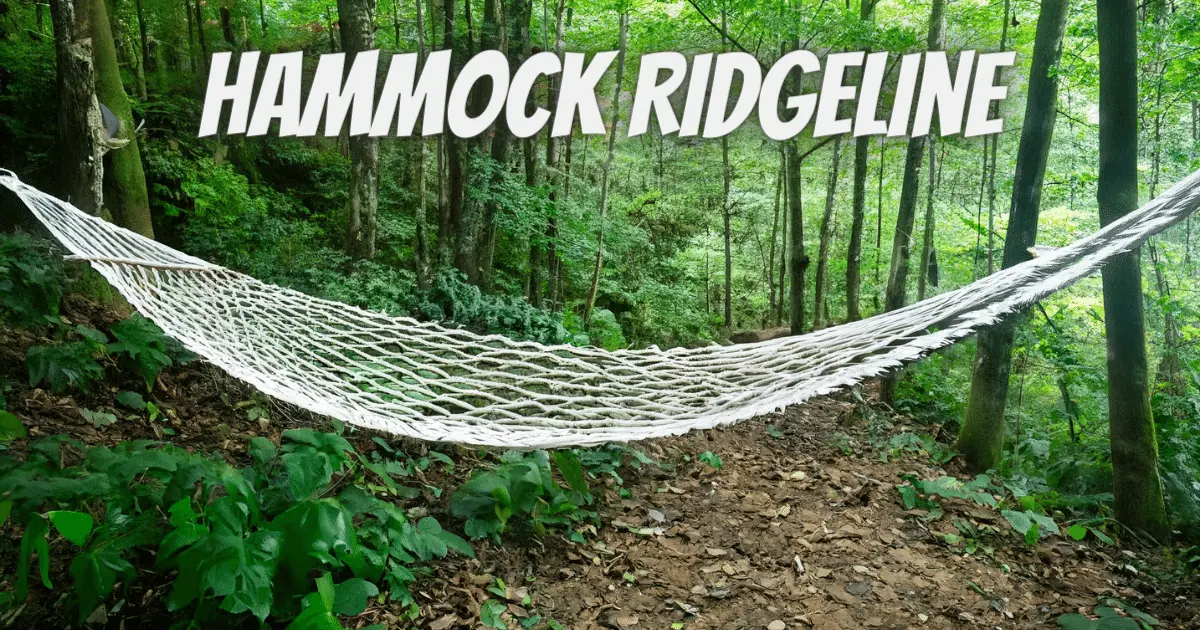One of the keys to achieving maximum comfort and function from a camping hammock is proper ridgeline setup. This guide rope runs the length of the hammock, allowing you to hang gear and accessories while providing shape and support. Following a few basic guidelines for calculating length, tensioning, and hanging the ridgeline will transform your hammock into an optimal sleep and relaxation system.
An Introduction to Hammock Ridgeline
For beginners new to the concept, here’s a quick overview of hammock ridgelines:
Definition
A ridgeline is a rope anchored at both ends of the hammock that runs above you as you lay inside. It creates structure and allows you to hang items from it.
Purpose
Ridgelines allow gear attachment and shaping of the hammock for flatter sleeping angles. They also take the weight that would otherwise stress hammock ends.
Types of Hammock Ridgeline
Most are made of polyester, nylon, or UHMWPE ropes. Some incorporate a cord with a secondary line to hang gear from. Kits include ridge tapes that attach to straps.
Uses for Hammock Ridgeline
- Hanging water bottles, phones, lanterns, packs
- Keeping bug net off the face
- Adjusting hammock sag and orientation
- Drying wet socks or clothing
- Attaching gear lofts, organizers, and shelves
Calculating Ideal Hammock Ridgeline Length

Determining the perfect Hammock Ridgeline length is an essential first step. Here is how to calculate:
Gather Info
Measure your hammock end-to-end length when hung normally. Determine desired sag (10-30% of length). Factor suspension strap length.
Basic Formula
Ridgeline Length = Hammock Length + (Hammock Length x Desired Sag %) + Distance Between Anchor Points
Example Calculation
- Hammock Length: 10 ft
- Desired Sag: 20%
- Suspension Straps: 6 ft end-to-end
- Formula: 10 ft + (10 ft x .20) + 6 ft = 10 ft + 2 ft + 6 ft = 18 ft ridgeline length
Consider Weight
Account for sag produced by a loaded hammock. Test hang with your typical weight to better calibrate.
Installing and Tensioning the Hammock Ridgeline

Once you know the ideal length, it’s time to install and tension the ridgeline:
Attachment Points
Use carabiners or knots to secure rope ends to hammock suspension approximately 6-12 inches from strap ends.
Feed Through Channel
Thread line through integrated channel if present. Otherwise, suspend just on top.
Apply Tension
Pull ridgeline taught between anchors but avoid excessive tension. Allow just enough slack for some sag when weighted.
Finishing Touches
Melt rope ends or use end caps to prevent fraying. Consider adding line locks or tensioners to easily adjust occasionally.
Test and Tweak
Weight the hammock, observe sag and adjust ridgeline tension as needed until optimal. Mark the ideal settings for quick setup next time.
Hanging Accessories from the Hammock Ridgeline

One of the best uses for a ridgeline is conveniently hanging items right where you need them:
Gear Loft/Pockets
Great for stashing headlamps, glasses, books, and water bottles. Ensure not too heavy for ridgeline strength.
Lantern
Hang a compact LED lantern by its handle or using a hook. Position it sufficiently above face height.
Shelves
Small removable shelves with integrated hooks allow placing drinks, phones, and tablets within easy reach.
Wet Clothes/Socks
Drape damp clothing along the ridgeline utilizing clips. Monitor closely to avoid drips.
Bug Netting

Tie cord loops to hold the mesh canopy off the face, allowing unobstructed views.
Water Bottle Holster
Special pouches can hand water within sipping reach via the ridgeline.
Additional Gear
Carabiners allow clipping of all types of extra gear to the ridge. Just don’t overload.
Hammock Ridgeline Tips for Comfort and Convenience

Follow these tips when utilizing your hammock’s ridgeline:
- Start with recommended 30% sag then adjust to find your sweet spot
- Lie at a diagonal to maximize flatness edge-to-edge
- Angle set up based on conditions (rain, sun, views, etc.)
- A clear line of any knots or tangles frequently
- Inspect for wear and replace if any damage develops
- Leave some slack on the non-structured side to make entering and exiting easier
- Use tennis balls or socks over the ends to prevent fraying
- Carry a spare ridgeline or repair supplies
- Utilize line locks to easily tighten or loosen occasionally
- Manage weight distribution and avoid concentrating too much in the center
- Position hooks, loops, and accessories strategically within reach
- Hang only lightweight items to avoid excessive sagging or failed components
Troubleshooting Common Hammock Ridgeline Issues
If you encounter any of these problems with your ridgeline, try these troubleshooting tips:
Too Much Sag
Tighten at ends, reduce weight, and check for damaged lines or connectors.
Too Little Sag
Loosen rope or reduce overall ridgeline length. The ideal is between 10-30% sag.
Uneven Hanging
Adjust suspension lengths or connection points for level orientation.
Line Unthreading
Remove all weight, detach line, redo channel threading, reattach, and reset.
Gear Sliding or Spinning
Use carabiners, wire hooks, or netting to secure items firmly in place on the ridgeline.
Tandem Imbalance
With two people, the heavier person lies on a diagonal through the main suspension points.
Unpleasant Pressure Points
Add a structural insulator sleeve over the ridgeline rope for more comfort.
Enjoy Ultimate Hammock Relaxation
A properly set up ridgeline makes all the difference when it comes to comfort and convenience from a camping hammock. Following these tips will help you get the length, tension, and accessory positioning dialed in. In no time, you’ll have the ultimate hangout allowing you to relax in complete comfort. Hang loose and enjoy the simplicity of hammock camping!
Frequently Asked Questions About Ridgelines
What is the best rope material for durability?
Nylon and polyester ropes work well. Some prefer UHMWPE ropes like Dyneema for strength, limited stretch, and weather resistance.
Can you set up a ridgeline with a gathered-end hammock?
Yes, use the main suspension points to anchor ridgeline ends. You may need to account for differences in overall length.
Are ridgelines absolutely necessary for hammock camping?
While not essential, they offer many beneficial uses. Hammocks still function without them. Add water if desired.
Can you leave a ridgeline permanently set up or must it be reset each time?
A permanent setup is possible provided you protect rope ends. Just inspect periodically for any wear and replace when needed.
What are indicators that it is time to replace your Hammock Ridgeline?
Signs include fraying, abrasion damage, cuts, discoloration, broken strands, knots, lost tension, or a feeling it is generally weakened through use and weathering.
You May Also Like

My name is David James I am an adventurous hiker based in California. Through this weblog, I percentage my passion for exploring nature’s wonders, documenting breathtaking trails and hidden gemstones.



